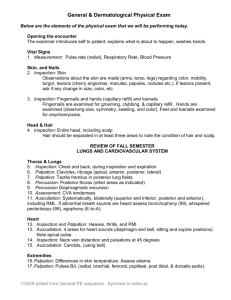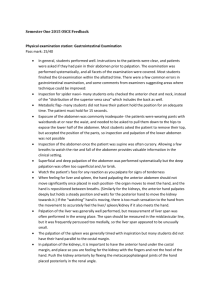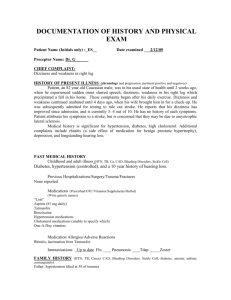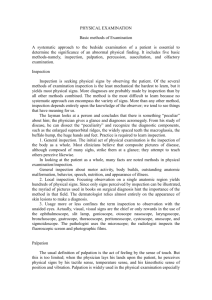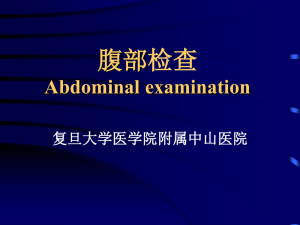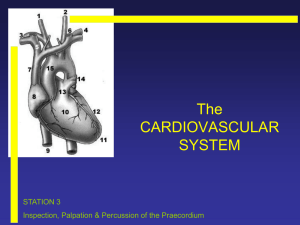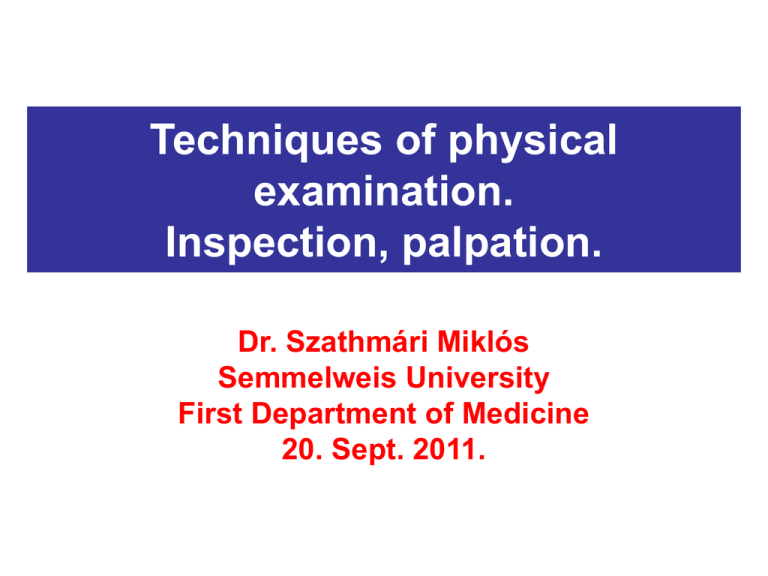
Techniques of physical
examination.
Inspection, palpation.
Dr. Szathmári Miklós
Semmelweis University
First Department of Medicine
20. Sept. 2011.
General considerations
• You should wash your hand in the presence
of the patient before beginning the physical
examination
• A new patient warrants a complete
examination, regardless of chief complaint
• The sequence of comprehensive examination
should maximize the patient’s comfort
• As a beginner, you should avoid interpreting
your findings for the patient
The comprehensive physical
examination; first impressions
• General survey: general state of health;
height, weight, build, sexual development,
motor activity, facial expression, state of
awareness or level of consciousness.
• Vital signs: blood pressure, pulse number
and respiratory rate.
• Skin: color, lesions. Inspection and
palpation of hair and nails.
Acromegaly
Alveolar bone
growth causes the
teeth to separate
The enlargement of the
frontal and maxillary
sinuses results in an
prominent brow and long
face
Growth of
mandible leads to a
jutting jaw
(prognathism).
Acromegaly
Characteristic clinical appearance manifest by coarsening of facial
features due to an increase of connective tissue
Acromegaly
Macroglossia. There is
also generalized visceral
enlargement
Broadening and enlargement
of the hands and feet due to
increased periosteal growth as
well as thickening of the skin
Appearence and behavior
• Facial expression
–
–
–
–
The stare in hyperthyroidism
Immobile face of parkinsonism
Sad face of depression
Decreased eye contact may suggest anxiety, fear or
sadness
• Memory, attention
– Remote: inquire about birthdays, names of schools
attended, jobs held, or past historical events.
– Recent : Actual date? which day is today?
Graves’ disease
Ocular involvement is mediated by
one or more distinct but still poorly
characterised orbital-stimulating
immunoglobulins:Proptosis, due to
increased volume and edema of
retrobulbar fat. Shortened
extraocular muscles, because of the
muscle infiltration and fibrosis result
in upper lid retraction. Conjunctival
erythema, and periorbital edema are
evident.
Facial expression
The stare in hyperthyroidism
Hypothyroidism
• The most common cause
is the Hashimoto’s
thyroiditis, affects appr. 1%
of adult population
This woman demonstrates
the typical hypothyroid
facies. She also had a
slow, hoarse, deep voice
and lassitude (state of
feeling very tired in mind or
body).
• Dull, puffy facies. Edema
does not pit with pressure.
The lateral eyebrows are
thin.
Inspection of the face
• Acromegaly: Enlargement of both bone and
soft tissues. The head is elongated, with bony
prominence of the forehead, nose and lower jaw.
Soft tissues of the nose, lips, and ears also
enlarge.
• Cushing’s symdrome: moon face with red
cheeks. Excessive hair growth may be present.
• Myxedema: Dull, puffy facies. Edema does not
pit with pressure. The lateral eyebrows are thin.
• Nephrotic syndrome: Edematosus and often
pale face. Swelling usually appears first around
the eyes and in the morning.
Appearence and behavior
• Level of consciousness
– Is the patients awake and alert?
– Does the patient seem to understand your questions
and respond appropriately or is there a tendency to
lose track of the topic and fall silent or even sleep? If
the patient does not respond, escalate the stimulus in
steps:
• Speak to the patient in a loud voice
• Shake the patients gently
• If there is no response that means severe reductions in the
level of consciousness (stupor or coma)
Appearence and behavior
• Posture and motor behavior
– What is the patient’s preferred posture?
• Preference for sitting up in left-sided heart failure
• For leaning forward with arms braced in chronic obstructive
pulmonary disease.
– Is the patient restless or quiet?
• Fast, frequent movements of hyperthyreoidism
• Slowed activity of hypothyroidism
– Is there any apparent involuntary motor activity?
• Tremor?
• Paralysis?
The typical position of COPD
patients
An elderly patient who looks chronically ill. He is unable to speak more than
two or three words at a time due to shortness of breath. He has intercostal
muscle retraction when breathing and sits upright. Hi is thin with diffuse
muscle wasting.
Appearence and behavior
• Dress, grooming and personal hygiene
– How is the patient dressed?
• Excess clothing – cold intolerance –
hypothyroidism
• Cut-out holes or slippers may indicate gout, untied
slippers suggests edema
– Do personal hygiene and grooming seem
appropriate to the patients’s age?
• Unkempt appearence may be seen in depression
and dementia
• Fingernails chewed to the quick may reflect stress
Inspection of the skin
Color:
•
•
•
•
Increased pigmentation (browness)
Loss of pigmentation (vitiligo)
Redness (the color of oxyhemoglobin)
Pallor (best assessed where the horny layer of the epidermis is
thinnest – fingernails, the lips, mucous membranes, particularly
those of the mouth and the palpebral conjunctiva)
• Cyanosis (best identified in the lips, oral mucosa and tongue).
Central (heart failrue, advanced lung disease, abnormal
hemoglobin), peripheral (decreased blood flow, venous obstruction)
• Jaundice (sclera)
Lesions:
• Anatomic location (acne affects the face, upper chest, psoriasis
knees and elbows, candida infection: intertriginous areas)
• Distribution: Vesicles in a unilateral dermatomal pattern are typical
of herpes zoster
Browness and depigmentation
Cyanosis
Bluish discoloration of nail beds and fingertips, usually
associated with hypoxemia and/or hypoperfusion.
Jaundice
Herpes zoster
•Vesicles in a unilateral dermatomal pattern are typical of herpes zoster
Spider angioma
From very small to 2 cm; pulsatility is often demonstrable, when
pressure with a glass slide is applied. Distribution: upper trunk,
face, arms.
The comprehensive physical
examination
• Eyes: Check visual acuity, screen the visual
fields. Inspection of sclera and conjunctiva.
Compare the pupils, test their reactions to light.
Asses the extraocular movements.
• Ears: Inspection of auricles, canals. Check
auditory acuity.
• Nose-sinuses: Inspection of nasal mucosa and
septum. Palpate for tenderness of the frontal
and maxillary sinuses.
• Throat: Inspection of lips, oral mucosa, teeth,
tongue, tonsils and pharynx.
Inspection of the eyes
• Position and abnormalities of the eyes and
eyelids
– Ptosis: Dropping of the upper lid (myasthenia gravis,
damage of oculomotor nerve, and damage to the
sympathetic nerve supply)
– Exophthalmos: the eyeball protrudes forward. When
bilateral, it suggests the infiltrative ophthalmopathy of
Graves’s disease.
– Periorbital edema: because the skin of the eyelids is
loosely attached to underlying tissues, edema tends
to accumulate there easily. Causes: allergy,
myxoedema, nephrotic syndrome.
Protruded eyeballs and periorbital
edema
The comprehensive physical
examination
• Neck: Inspection and palpation of cervical lymph
nodes. Inspection and palpation of the thyroid
gland. Deviation of the trachea. Observe sound
and effort of the patient’s breathing.
• Thorax and lung: Inspection and palpation of
spine and muscles of the upper back.
Inspection, palpation and percussion of chest.
Identification of the level of diaphragmatic
dullness. Listen to the breath sounds.
• Breast, axillae: Inspection and palpation of
breasts. Palpation of axillary nodes.
The comprehensive physical
examination
• Cardiovascular system:
– Observation of jugular venous pulsation
– Inspection, palpation and of carotid pulsation. Listen to carotid
bruits
– Palpation of the apical impulse
– Listen to heart sounds
• Abdomen:
–
–
–
–
Inspection, palpation and percussion of the abdomen.
Asses the liver and spleen
Try to feel the kidneys
Palpation of abdominal aorta, and its pulsation
• Genitalia and hernias in men:
– Examine the penis and scrotal contents and check for hernias
The comprehensive physical
examination
• Lower extremities:
– Peripheral vascular system: palpation of
femoral pulses and peripheral arterial pulses.
Inspection for varicose veins.
– Palpation of inguinal lymph nodes
– Palpation for piting edema
– Musculoskeletal system: palpate the joints,
check their range of motion.
– Nervous system: Assessing of muscle bulk,
tone and strenght; sensation and reflexes.
The comprehensive physical
examination
• Nervous system:
– Mental status: orientation, mood, abnormal
perceptions, memory, attention, calculating abilities.
– Cranial nerves: check sense of smell, strength of the
temporal and masseter muscles, corneal reflexes,
facial movements, gag reflex.
– Motor system: muscle bulk, tone and strength of
major muscle groups.
– Sensory system: pain, temperature, light touch,
vibration, and discrimination.
– Reflexes.
• Additonal examinations:
– Rectal digital examination
Inspection of tongue and region
under tongue
• Thick white coat on the tongue – candida
infection
• Smooth tongue: Loss of the papillae
suggests deficiency of riboflavin, niacin,
folic acid, B12 or iron
• Leukoplakia: a persisting painless white
patch in the oral mucosa. Precancerosis.
• Aphthous ulcer: painful, small, round or
oval ulcer that is white or yellowish gray.
Purpose of palpation
• Examination of the body surface (skin:
smoothness, dryness, irregularities etc.)
• Examination of internal organs (shape,
size, consistency etc.)
• To look for abnormal resistances
• Detection of painful areas
• To feel movement of fluids within the body
Palpation; general rules
• Cut your fingernails short
• Have warm hands
– If not, warm them by rubbings, washing in hot water
or start palpating through the gown of the patient
•
•
•
•
•
Use the pads of your fingers
Use both hands
Move them smoothly
Palpate first lightly, than perform deep palpation
Avoid causing pain to the patient
Palpation of the skin
• Moisture
– Dryness – hypothyroidism
– Sweating - hyperthyrodism
• Temperature
– Generalized warmth in fever or hyperthyroidism
– Local warmth of inflammation
– Coolness in hypothyroidism
• Mobility and turgor
– Lift a fold of skin and note the ease with which it lifts
up (mobility- decreased in edema)
– The speed with which it returns into place (turgor –
decreased in dehydration)
Characteristics of palpable mass
• Size:
– head of the pin, pepper, bean, peanut, green
nut, apple, fist of child or of an adult, head of
a child or of an adult etc.
• Surface:
– Smooth, nodular (micro/macro), lobulated,
irregular
• Consistency:
– Soft, glandular, rubbery, firm, hard (like
cartilage, wood, stone), fluctuating
Characteristics of palpable mass
• Mobility
– Freely moving (movable, shifting), attached to
skin or underlying tissue, matted together
(lymph nodes)
• Other palpable characteristics
– Pulsation
– Resonance
– Tenderness
– Bruise
Cervical adenopathy
Massive right side cervical adenopathy due to
metastatic, intraoral squamous cell cancer.
Palpation of lymph nodes
• Using the pads of your index and middle
fingers, move the skin over the underlying
tissues in each area
– The patient should be relaxed, with neck
flexed slightly forward and slightly toward the
side being examined.
– Note the size, shape, mobility, consistency
and any tenderness. Small, mobile, discrete,
nontender nodes are frequently found in
normal persons.
• Tender nodes suggest inflammation
• Hard or fixed nodes suggest malignancy

